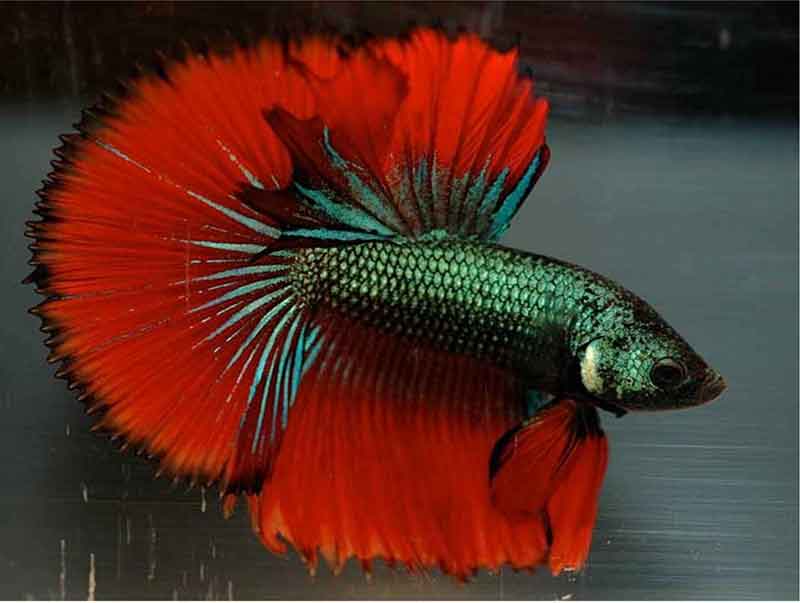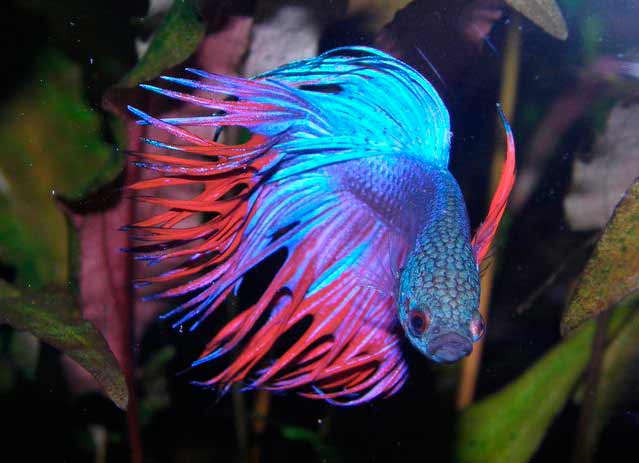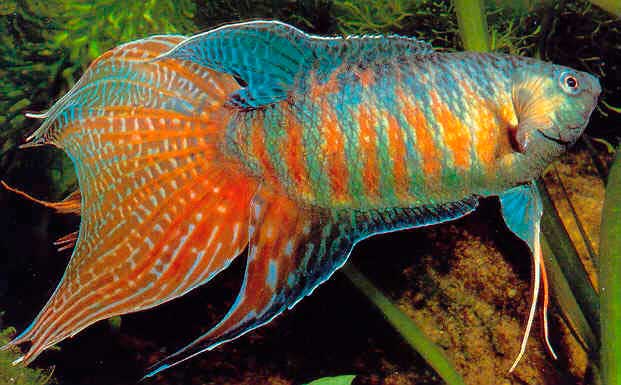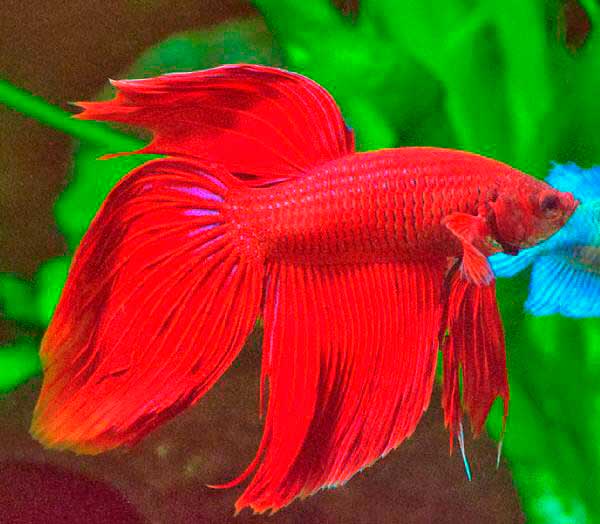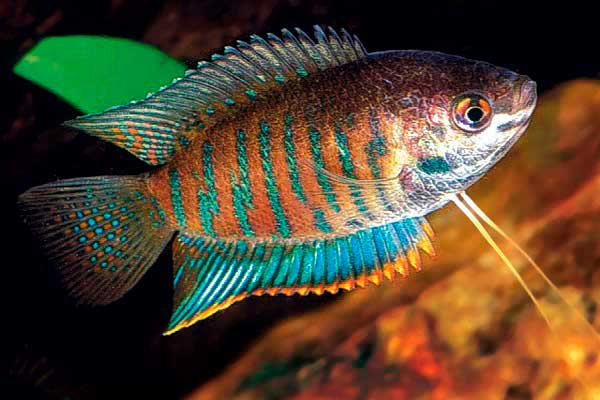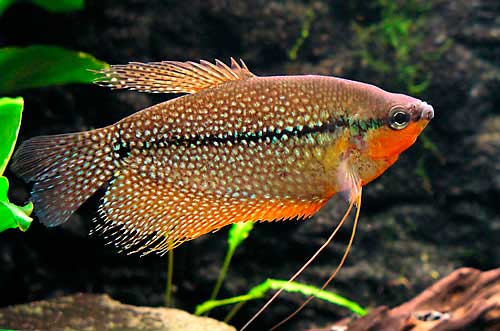Fighting fish, or cockerel, surprises with its species diversity, color range and beauty. The homeland of this species is Southeast Asia. It lives in standing or slowly flowing freshwater bodies. It is graceful, unpretentious and has a combative disposition.
If two males collide in the aquarium, they are sure to arrange a real “cockfight”, fluffing their luxurious fins and tails. Fish must be separated, otherwise one of them will surely die. Because of this resemblance to a pet bird, the cockerel got its name.
Maintenance and care
The Roosterfish is a labyrinth fish, i.e. it breathes atmospheric air. It is therefore necessary to keep the aquarium covered in order to prevent the air from cooling down and the fish from catching cold. But the lid should not tightly close the aquarium, so that the cockerels do not suffocate. Do not allow fluctuations in water temperature, it should remain at +24-28 ° C. Suitable aquarium is a small size. Aeration is not necessary, in addition, the fish are sedentary and excessive turbulence they do not need. Water filter can be put at your discretion. Light is needed in sufficient quantity.
When choosing plants, you should keep in mind the safety of the aquarium inhabitants. The leaves should not have sharp edges and the water surface should be free of plants. However, during the spawning period, it is necessary to throw on the surface of the water in the spawning tank a bunch of riccia or a little cassava. These plants males use to build a nest. It is better to fill the aquarium with live plants, rather than artificial. They will enrich the water with oxygen. Provide a hiding place for the fish and make room for swimming.
The aquarium should be cleaned at least once a week. Use a net to transfer the fish to a jar with the same water. Clean the aquarium and the ground with running water without detergent and fill again with clean water of the required temperature.
Diagnosis of diseases, ways to treat them
If you suspect something wrong with the behavior or appearance of your fish, it is necessary to diagnose the disease. A visual inspection for certain signs will help.
It is necessary to examine the fins, whether they are sticking together or not. If the color is pale and the body is covered with white growths, it is a sign of fungal infection. It can occur even in ideal aquariums. Since the fungus spreads very quickly, you need to start treating it sooner. Antifungal agents or aquarium salt should be added to clean water.
Next, examine for bloating or protruding scales. This sign is characterized by dropsy (bacterial infection of the kidneys). The fish’s kidneys begin to fail. As a consequence, fluid begins to accumulate in the body. This becomes the cause of bloating. Infection can be caused by contaminated food or poor aquarium condition. There is no cure for dropsy, but there is a chance to avoid the disease. You should not give contaminated food or live worms. All fish with symptoms of dropsy should be quarantined immediately to prevent the disease from spreading.
It is necessary to pay attention to whether there are white convex specks or spots on the body of the fish. This is a symptom of ichthyophthyriasis. It spreads from the head and front fins. The causative agent is the parasite infusoria-ichthioftirius. Fish do not eat well, become lethargic, rubbing against objects because of itching, there may be breathing problems. Causes for many: temperature fluctuations in the aquarium, contaminated water, overfeeding, not treated fish or plants. Curing this disease is becoming more and more difficult every year. New strains are successfully resisting old drugs.
It is important to see if the fins and tail have become ragged and faded. This symptom is characterized by “fin rot”. It belongs to a type of bacterial infections and is very common in roosterfish. The causative agents can be different bacteria, but all lead to the loss of fins. And if you run the disease, the fish can rot alive. It mainly occurs due to irregular cleaning of the aquarium, an excess of individuals, hooking up fish that have not been quarantined. In treatment, antifungal and antibacterial drugs are used.
To detect rusty plaque, shine a light on the fish. The presence of this indicates a velvet disease. Causes it very contagious parasite. Cockerel fish can scrape against the walls of the aquarium, the gravel, clench fins. It reduces appetite and faded color. In this case, be sure to treat all fish, even without symptoms.
Pay attention to how the cockerel swims. If it swims on its side or is motionless at the bottom of the aquarium, the function of the swim bladder is impaired. Frequent overfeeding leads to its bloating. As a result – the fish swims poorly. This defect is common. But it is correctable, and the fish do not die from this.
Inspect the body of the fish for pale greenish threads. This indicates an infestation of anchor worms (lerneosis). By traumatizing the skin, they penetrate the muscles and lay eggs there. The wounds they leave can become inflamed and itchy. The water must be changed and clean water treated with anti-parasitic drugs.
At any stage of a fighting fish’s life, there is a possibility of it becoming ill. Therefore, it is better to prepare in advance and stock up on medications. They can be found in a pet store. Keep an eye on the condition of the water, the dosage of the medication and use aquarium salt.fishes
